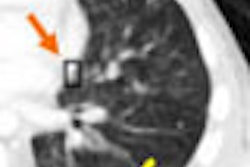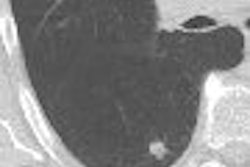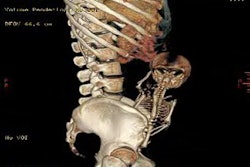A multinational study of 187 patients with suspected coronary artery stenosis found a higher number of false positives and nonevaluable coronary artery segments at 16-slice MDCT angiography than has been reported in previous studies.
Compared with conventional angiography, the results led the authors to conclude that low-dose 16-slice MDCT angiography should not be recommended for the routine nonemergency evaluation of patients with chest pain and an intermediate or high probability of coronary artery disease.
Instead they recommended stress testing and conventional angiography when indicated, though cardiac MDCT might be useful for excluding coronary disease in selected patients, the group wrote in this week's Journal of the American Medical Association.
"The primary hypothesis tested was whether MDCT could detect more than 50% luminal narrowing in coronary artery segments larger than 2.0 mm in diameter," with sensitivity and specificity of more than 85%, wrote principal investigator Dr. Mario Garcia from the Cleveland Clinic Foundation in Ohio, along with his colleagues from 11 centers in the U.S., Europe, Japan, and Argentina (JAMA, July 26, 2006, Vol. 296:4, pp. 403-411).
The results offered fresh insight into the routine clinical performance of an exam that had seen far better results in single-center studies and at academic facilities, where study conditions tend to be optimal. Yet the methodology was so rigorous as to call the poor MDCT results into question.
The authors relied exclusively on quantitative rather than qualitative evaluation of CT angiography results, for example, regardless of whether qualitative assessment might have yielded an accurate diagnosis -- as it often does in practice.
In addition, nearly a third of all segments were excluded from analysis due to the presence of motion artifact, poor opacification, and/or vessel size smaller than 2 mm. The authors acknowledged that default labeling of all of these vessels as positive for stenotic disease was a factor that decreased coronary CT angiography's diagnostic performance. The use of solely quantitative analysis was unwarranted, according to a cardiac imaging expert who provided extensive commentary for this article.
In the study, 187 patients (age 30-70) who referred for the evaluation of chest pain and for intermediate or high probability of coronary artery disease were examined with MDCT angiography and conventional angiography. Along with the normal MDCT contraindications such as elevated creatinine levels, morbid obesity, recent acute myocardial infarction, contraindication to beta-blockers, or arrhythmia, subjects were excluded if their coronary calcium scores were over 600, since extremely high calcium scores are known to decrease the performance of MDCT coronary angiography, and the probability of occlusive disease is high in any case, the authors noted.
Following a low-dose MDCT calcium scan, the 187 patients underwent cardiac MDCT angiography one to 14 days before conventional angiography using 16-detector MDCT scanners (Brilliance 16, Philips Medical Systems, Andover, MA).
The beta-blocker metropolol (up to 15 mg) was administered intravenously until the heart rate was below 65 beats per minute, or the maximum dose was reached; nonionic iodinated contrast material (80-130 mL of Isovue, Bracco Diagnostics, Princeton, NJ) was administered in a biphasic injection.
The voltage of 120-140 kVp and mAs of 400-500 were adjusted on the basis of patient mass. Images were reconstructed at several phases of the cardiac cycle and analyzed in a blinded fashion at the MDCT core laboratory at the University of Ulm in Germany.
Segment- and patient-based sensitivities and specificities for the detection of luminal stenosis of more than 50% were based on quantitative coronary angiography, the team wrote. Standard cardiac catheterization studies were performed, and the maximum percentage of lumen reduction was determined using standard software.
"Of 1,629 nonstented segments larger than 2 mm in diameter, there were 89 (5.5%) in 59 (32%) of 187 patients with stenosis of more than 50% by conventional angiography," the authors wrote. "Of the 1,629 segments, 71% were evaluable by MDCT. After censoring all nonevaluable segments as positive, the sensitivity for detecting more than 50% luminal stenosis was 89%; specificity, 65%; positive predictive value, 13%; and negative predictive value, 99%."
On a per-patient basis, sensitivity for detecting those with at least one positive segment was 98%, with specificity of 54%. The per-patient positive and negative predictive values were 50% and 99%, respectively.
MDCT did better for severe stenoses of 70% or more. "After censoring all nonevaluable segments as positive, the sensitivity for detecting more than 70% luminal stenosis was 94%; specificity, 67%; positive predictive value, 6%; and negative predictive value, 99%," the authors wrote. Per-patient sensitivity and specificity were 94% and 51%, respectively; the positive and negative values were 28% and 98%, respectively.
"The results of this multicenter study demonstrate a higher number of false-positive and nonevaluable segments than previously reported with MDCT coronary angiography," Garcia and colleagues wrote. "Because the prevalence of obstructive coronary artery disease was significant (38%) in patients with nonevaluable segments, these patients would need to proceed to conventional angiography or additional noninvasive testing in clinical practice...."
If all nonevaluable MDCT segments were excluded (or considered negative), 15 patients with stenosis of more than 50% would have been missed.
"Multidetector CT coronary angiography may be useful to exclude coronary artery disease in selected patients in whom a false-positive stress test result is suspected," they wrote. And they considered MDCT's negative predictive value to be a powerful tool.
"Our results indicate that a negative MDCT coronary angiogram could have a significant discriminative power to exclude significant stenosis in patients with intermediate probability in the absence of nonevaluable segments," the authors wrote. "In this study population, if clinically implemented, a negative evaluable MDCT study may have avoided conventional angiography in 69 (37%) of 187 patients, while missing only one patient with single vessel obstructive disease (0.4%)."
The authors acknowledged limitations in the methodology that decreased MDCT's diagnostic performance. "Use of purely quantitative analysis appears to have had a major impact on overdiagnosis in the presence of calcified lesions, many of which may have been scored as insignificant based on subjective analysis alone," they wrote. "Small and poorly opacified arteries were often judged as nonevaluable because of the requirement to analyze lesions quantitatively."
In a recent comparable study of MDCT and angiography, "quantitative analysis could be performed in 88% of available segments, whereas quantitative analysis was only feasible in 73%," the team wrote.
In other limitations, the group noted that the number of nonevaluable segments may have been overestimated by the decision not to use sublingual nitroglycerine, by limiting the dose of the beta-blocker, and by the use of tube current modulation, which limits the ability to interpret coronary anatomy.
Nevertheless, the results showed that MDCT coronary angiography performed with 16-row scanners "is limited by a high number of nondiagnostic cases," the authors wrote. "Thus, routine implementation of MDCT angiography as a primary diagnostic test to evaluate patients with suspected coronary artery disease would lead to an excessive use of conventional angiography, additional confirmatory noninvasive testing, or both.
At the same time, the high sensitivity and negative predictive value of MDCT angiography suggest that when selectively applied, MDCT may be a useful alternative to conventional angiography in selected patients with undetermined or suspected false-positive stress test results.
More tests are needed to determine if MDCT angiography performed with the current generation of 64-slice scanners improves performance enough to justify the routine use of MDCT as a primary diagnostic test, the group added.
Until then, "stress testing should remain as the primary diagnostic modality for this purpose until further data obtained with newer generation MDCT technology demonstrates improved performance characteristics," the authors concluded.
Commentary from an MDCT angiography expert
In an e-mail to AuntMinnie.com, Dr. U. Joseph Schoepf, associate professor of radiology and medicine at the Medical University of South Carolina in Charleston, lauded the study authors for providing a real-world assessment of MDCT angiography in practice that is often lacking in academic centers and single-center studies.
"The accuracy numbers of coronary CTA (CT angiography) that we have been seeing in the literature so far, without exception, originate out of high-level academic institutions, who pursue coronary CTA as a research subject," he wrote. "Thus, the results of those previous, single-center trials are difficult to generalize for routine use across the country."
The choice of study centers was probably one reason the results were so much worse than in previous studies, and there are other reasons as well, Schoepf noted.
"First, the quality of coronary CTA acquisition will very much depend on the experience of the participating centers and will differ substantially across institutions," he wrote. "Considering the above, this is not necessarily undesirable as such a setting more closely resembles reality. Secondly, although multicenter, this is a single-vendor trial. The results may be difficult to generalize with regards to results obtainable on different 16-slice CT scanners on the market, which may have different specifications."
The methodology may have also stacked the deck against MDCT, according to Schoepf.
"The authors chose to evaluate their data in such a manner that they excluded 472 segments (29%!) from their analysis, because of motion artifacts, poor opacification, and small vessel size," Schoepf wrote. "This approach is reminiscent of the very early days of coronary CTA, where severe technical limitations may have justified such strategies. The authors chose to designate every single one of those segments as positive ... although only a very small minority of those (24) were actually stenosed. This analytical strategy, understandably, will decrease CTA's diagnostic performance. Nowadays, therefore, most investigators prefer an approach that includes all coronary artery segments, without exclusions, which should provide for a more realistic assessment of diagnostic accuracy."
Finally, Schoepf wrote, it is somewhat contradictory to recommend against the routine clinical use of MDCT angiography, while recommending its use in patients suspected of having false-positive or inconclusive stress test results.
"The second statement clearly outlines an avenue for routine clinical implementation in clinical practice," Schoepf wrote. "Coronary CTA for excluding significant coronary disease in patients with equivocal results at other tests, who would otherwise undergo invasive catheter angiography, is a powerful clinical application and is the most common indication for performing coronary CTA at our institution."
Certainly MDCT's limitations for stenosis detection and grading are well-recognized, Schoepf wrote. "If, however, patient management is primarily based on the high negative predictive value for excluding disease, many patients will be saved from unnecessary diagnostic catheterizations, likely with beneficial effects on the healthcare environment."
By Eric Barnes
AuntMinnie.com staff writer
July 26, 2006
Related Reading
Cardiac CTA a no-go zone for some, July 17, 2006
Less radiation dose exposure in cardiac CT is possible, July 6, 2006
Dual-source imaging promises better CT scanning, June 15, 2006
CT angiography detects significant coronary lesions prior to valve surgery, June 8, 2006
Concentrated iodine permits lower volumes in cardiac CTA, May 22, 2006
Copyright © 2006 AuntMinnie.com



















